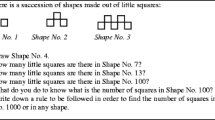Abstract
This article presents a constructivist approach for teaching mathematics to prospective elementary school teachers in USA. This approach employs a model of a “mathematical situation,” a set of physical operations and a physical language to reason about students’ mathematical doings. One of the primary goals of this approach is to promote a reasoning attitude toward the learning of mathematics by prospective elementary school teachers. At the same time this approach encourages the development of their reasoning skills. This approach provides a less rigid frame for discussing mathematics “doings”, [The word “doings” in this manuscript refers to the variety of mathematical activities, from thinking on a mathematical problem, using manipulatives, graphing, solving and so forth.] which is still structured enough to allow prospective teachers to appreciate the kinds of doings and argumentations found in mathematics. It provides a concrete-like basis that serves to promote the understanding of arithmetical concepts (especially fractions). In the context of teacher education, this approach adds structure and content to the usual curriculum of basic mathematics courses for future elementary and middle school teachers. It grants future teachers a higher degree of flexibility in dealing with their students’ questions and learning difficulties.
Similar content being viewed by others
References
Dreyfus T., Hadas N. (1996) Proof as answer to the question why. International Reviews on Mathematical Education 28(1):1–5
Hersh R. (1993) Proving is convincing and explaining. Educational Studies in Mathematics 24(4):389–399
Fischbein, E. & Kedem, I. (1982). Proof and certitude in the development of mathematical thinking. In A. Vermandel (Ed.), Proceedings of the Sixth International Conference for the Psychology of Mathematical Education (pp.128–131). Antwerp
Fischbein E. (1987) Intuition in science and mathematics: An educational approach. Reidel, Dordrecht
Moore, J. L. & Schwartz, D. L. (1994). Show how you know: A visual medium for demonstrative discourse. Paper presented at the Annual Meeting of the American. Educational Research Association (New Orleans, LA, April 4–8, 1994)
Peretz D. (2005) Inverse mathematical model – yet another aspect of applications and modeling in undergraduate mathematics for prospective teachers. Teaching Mathematics and its Applications Journal 24(2–3):134–142
Richards J. (1991) Mathematical discussions. In: von Glasersfeld E. (ed) Radical constructivism in mathematics education. Kluwer, Dordredcht, The Netherlands, pp. 13–51
Selden J., Selden A. (1995) Unpacking the logic of mathematical statements. Educational Studies in Mathematics 29(2):123–151
Yore, L. D. (2001). What is meant by constructivist science teaching and will the science education community stay the course for meaningful reform? Electronic Journal of Science Education 5(4)
Author information
Authors and Affiliations
Corresponding author
Rights and permissions
About this article
Cite this article
Peretz, D. Enhancing Reasoning Attitudes Of Prospective Elementary School Mathematics Teachers. J Math Teacher Educ 9, 381–400 (2006). https://doi.org/10.1007/s10857-006-9013-9
Received:
Accepted:
Published:
Issue Date:
DOI: https://doi.org/10.1007/s10857-006-9013-9




